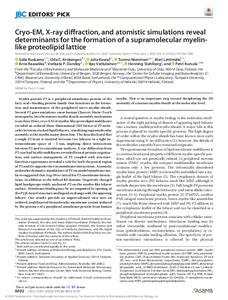Cryo-EM, X-ray diffraction, and atomistic simulations reveal determinants for the formation of a supramolecular myelin-like proteolipid lattice
Ruskamo, Salla; Krokengen, Oda C.; Kowal, Julia; Nieminen, Tuomo; Lehtimäki, Mari; Raasakka, Arne; Dandey, Venkata P.; Vattulainen, Ilpo; Stahlberg, Henning; Kursula, Petri (2020-06-26)
Ruskamo, Salla
Krokengen, Oda C.
Kowal, Julia
Nieminen, Tuomo
Lehtimäki, Mari
Raasakka, Arne
Dandey, Venkata P.
Vattulainen, Ilpo
Stahlberg, Henning
Kursula, Petri
26.06.2020
Julkaisun pysyvä osoite on
https://urn.fi/URN:NBN:fi:tuni-202202101907
https://urn.fi/URN:NBN:fi:tuni-202202101907
Kuvaus
Peer reviewed
Tiivistelmä
Myelin protein P2 is a peripheral membrane protein of the fatty acid-binding protein family that functions in the formation and maintenance of the peripheral nerve myelin sheath. Several P2 gene mutations cause human Charcot-Marie-Tooth neuropathy, but the mature myelin sheath assembly mechanism is unclear. Here, cryo-EM of myelin-like proteolipid multilayers revealed an ordered three-dimensional (3D) lattice of P2 molecules between stacked lipid bilayers, visualizing supramolecular assembly at the myelin major dense line. The data disclosed that a single P2 layer is inserted between two bilayers in a tight intermembrane space of ∼3 nm, implying direct interactions between P2 and two membrane surfaces. X-ray diffraction from P2-stacked bicelle multilayers revealed lateral protein organization, and surface mutagenesis of P2 coupled with structure-function experiments revealed a role for both the portal region of P2 and its opposite face in membrane interactions. Atomistic molecular dynamics simulations of P2 on model membrane surfaces suggested that Arg-88 is critical for P2-membrane interactions, in addition to the helical lid domain. Negatively charged lipid headgroups stably anchored P2 on the myelin-like bilayer surface. Membrane binding may be accompanied by opening of the P2 β-barrel structure and ligand exchange with the apposing bilayer. Our results provide an unprecedented view into an ordered, multilayered biomolecular membrane system induced by the presence of a peripheral membrane protein from human myelin. This is an important step toward deciphering the 3D assembly of a mature myelin sheath at the molecular level.
Kokoelmat
- TUNICRIS-julkaisut [16977]
